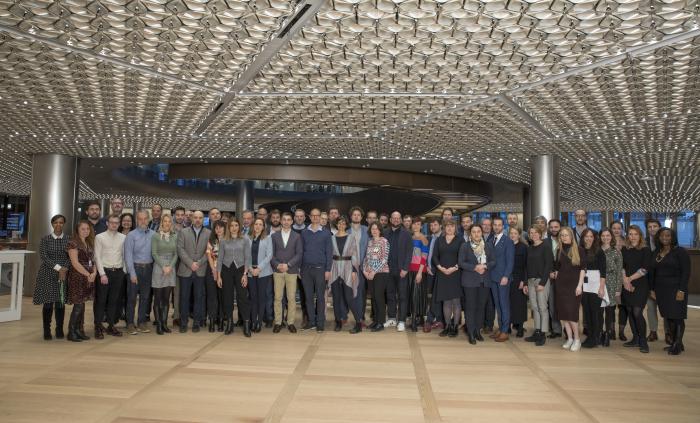European cities aim for new heights in digital innovation

Of the many lessons for city leaders to emerge out of the COVID-19 pandemic, two of the most crucial are around digital innovation: first, how critical digital transformation is to sustaining essential service delivery and second, how integral resident engagement—and quick, iterative improvements as a result of that engagement—is to this work.
Now, as cities begin to turn their attention from keeping up services toward strengthening and building upon those services, leaders from a number of European capitals are leveraging these insights to take digital innovation to new heights. As part of their participation in the Bloomberg Philanthropies Digital Innovation Initiative, these cities are both maintaining a pandemic-era urgency around transformation and doing so in ways that radically reimagine cities’ relationships with residents.
“In this moment of rapid, fundamental social change accelerated by the pandemic, we have seen that digital innovation is crucial to solving today’s biggest challenges,” said Louise Ellaway of the Bloomberg Philanthropies Government Innovation team. “Putting it to work requires bold leadership and a commitment to changing organizational culture in a way that puts residents’ needs first.”
To learn more about these efforts, Bloomberg Cities caught up with the civil servants leading them. In all cases, their cities started with a problem they aimed to solve—streamlining housing maintenance requests in Dublin, say, or helping jobseekers find employment in Helsinki—and worked with people on all sides of the issue to better understand the problem and constantly refine the solutions. While the projects remain at different stages of development, crucial new connections have been made between city halls and residents. Here’s a snapshot of what these cities have learned so far.
Making bill payments less taxing in Bratislava, Slovakia
In 2016, the city of Bratislava set up a new, €4 million web portal to handle most service transactions for the city’s 200,000 residents, including an annual property tax. Residents found the service to be hard to use, however, and few took advantage of it; 98 percent of the property-tax transactions continued to be handled in person through the city’s main tax office.
Mária Kostická, innovation manager for the Bratislava city municipality, has been building relationships with tech and legal colleagues to come up with a new approach. The city did initial surveys online and via Zoom with residents to understand why residents had difficulty accessing the current site. Says Kostická of this resident engagement: “There are no right and wrong answers, just an honest opinion.”
The city plans to release a greatly simplified and more user-friendly digital tax service in July and has improved the way it communicates with residents to better explain the new process, show where their information goes, and offer tips on how best to communicate with the property tax service.
Kostická says what she and her colleagues have learned about how to involve residents and lead workshops will carry over into other digital initiatives going forward. “It's not only about this one project because we can and will definitely apply it to others,” she says.
Repairing communications with tenants in Dublin, Ireland
Dublin City Council wants to modernize the way it handles requests for repairs in the social housing units they manage so the council can categorize jobs and plan work more effectively. The city receives more than 60,000 housing repair requests annually but the existing paper-based system often leads to delays and errors. In addition to increasing the number of completed repairs, the city wants to communicate better with tenants about when repairs will be made.
A central issue arising from the interviews with stakeholders was the need for more accurate and up-to-date information. One solution: Dublin leaders have set up an app for tradespeople to receive repair requests and for tenants to receive live information about when repairs will be made. Another idea is to research diverse ways for tenants to report needed repairs themselves, with one possibility being using an ATM-style machine to put in a request.
Mark Geoghegan, area maintenance officer, says re-examining processes in this area has helped to create better channels of communications within the city government and begin tearing down silos. This project helps people who aren’t on the front line of service delivery better understand the needs of the people who are accessing the service, Geoghegan explains.
Improving prospects for job seekers in Helsinki, Finland
Helsinki is looking to streamline its services for helping jobseekers find work. The existing system does not support the kinds of quality interactions with jobseekers that can best help them find services and work opportunities that are a good match for their skills and life situation.
To find ideas for improvements, the city conducted one-on-one interviews with jobseekers from various backgrounds to hear their experiences with city employment services, as well as their needs and hopes. After this discovery phase, the focus has moved to prototyping and testing ideas with users, with plans to redesign ways of working in employment services and find tools to support better interactions with residents who are looking for work.
“The importance of the human factor on digital transformation must not be forgotten or ignored,” says Kati Rinne, senior planning officer and project lead for the Helsinki unemployment service project. “Following the human-centered design process has shown us that before developing any tech solutions, we have to have a deep understanding of the user’s real needs and how these needs could be answered.”
A digital fix to improve waste collection in Prague, Czech Republic
Waste management in Prague is a complicated system, relying on four different waste management companies. Sometimes, residents complain that their waste bins aren’t emptied regularly; other times, bins get emptied even though they aren’t full.
Before the city could think about how digital transformation could fix these problems, project co-coordinator Zina Kaštovská says they first had to figure out what parts weren’t working. “We have asked every stakeholder for each part in the service about how it works,” Kaštovská says, “so now I think it's more clear how everything is connected.”
Now, the team is ready to launch a device-management system that features real-time digital monitoring of 550 waste containers to optimize collection and ensure sufficient capacity for citizens to drop off materials. Kaštovská expects the human-centered research that went into the decision to use that technology will pay big dividends in better waste services for Prague residents.
Building a two-way conversation with residents in Sofia, Bulgaria
The city of Sofia is using a citizen-centered approach to improve its effectiveness, starting with how residents register their address online to access municipal services. At the moment, registration across the city's 24 districts is done in different ways and therefore is patchy and fragmented.
Over the past year, the city has engaged residents via Zoom calls to collect detailed feedback on their ideas for how to make that process work more smoothly. Antonia Shalamanova, an associate at the city’s development association, says the project is helping city leaders learn how to engage residents in problem solving and ground their work in two-way communication.
“We should engage our citizens more and try to better understand their needs, and find ways of getting constant feedback,” Shalamanova says. “Because sometimes, there is a communication gap.”
Shalamanova adds that this citizen-focused approach to digitizing services could be applied to other areas, such as working to improve the environment or urban mobility.
Engaging residents in city planning in Tallinn, Estonia
When it comes to decisions about new development that will change their neighborhoods, Tallinn residents say it can be difficult to know what is coming and how to make their opinions heard.
Maarja Kõue’s team aims to change this. Kõue is a geographic-information system specialist who has grown into the role of team leader during this project. When her team reached out to residents via Facebook groups for help redesigning the public feedback process around city planning, 70 people—well more than they expected—reached out. The team has also worked with residents to prototype ideas such as 3-D visualizations of proposed developments. The hope is that by helping residents understand sooner how new buildings and areas will be developed—and how that development will affect their lives—they can respond earlier with more productive public feedback.
Kõue shared this human-centered learning from the project: “Applying new technologies and ways of working in the public sector takes a lot of effort. To get staff members on board, it’s crucial to see things from their perspective and figure out what are their user needs and potential blockers for the change.”
Supporting older residents at home in Vilnius, Lithuania
Helping older residents in Vilnius stay in their own homes as they age is the focus of the city’s digital innovation project.
Adult social care in the city is confusing, hard to navigate, and often expensive. Before this project launched, Vilnius seniors waited between three months and two years to access social care services. City officials want to make it easier for older residents to understand what their options are, how the city can help, and how much it will cost.
The city has set up a website for older people, their families, and caregivers to access information about how they can stay at home. This includes a list of services available to meet the different needs of seniors, and a cost calculator to work out exactly how much they will have to pay for at-home care. Plans are in the works for an additional online resource to help residents find equipment that can help them stay mobile within their homes as they age.
These ideas were based on feedback from stakeholders on all sides of the adult-care continuum. “The strong point of this project,” says Aleksandra Černiauskienė, who is managing it, “is that we go and speak with all the people involved: doctors, community members, elected representatives, social services and social workers.”
Vilnius and the other European cities will be launching their new services later this year, said Ellaway of Bloomberg Philanthropies. They’ll also begin scaling their new ways of working to other services, and sharing what they’ve learned with other cities across Europe and around the world.
“Cities that have embraced digital innovation have been ahead of the game in their response to COVID-19,” Ellaway said. “And they’ll be well positioned to deliver better results for residents coming out of the pandemic, as well.”


